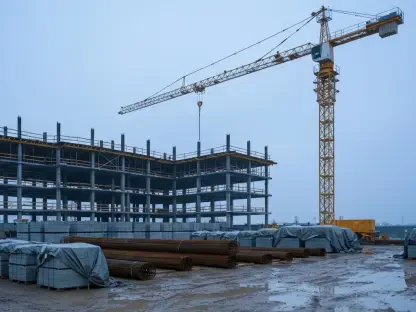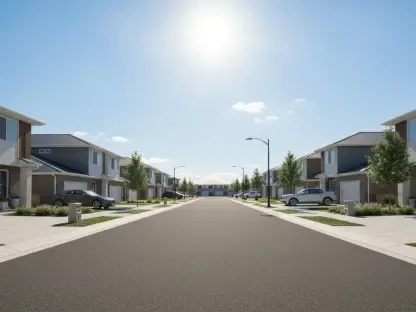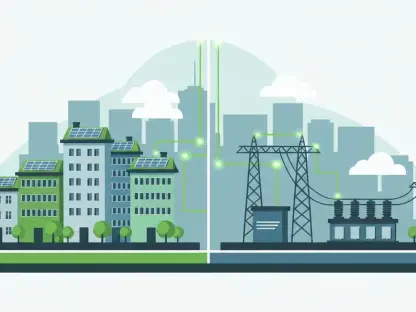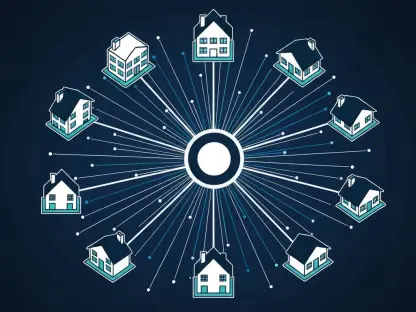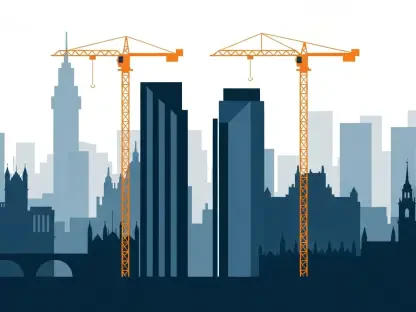Natural disasters are becoming increasingly frequent and severe, posing a significant threat to buildings and human lives. Integrating IoT (Internet of Things) and smart design is emerging as a critical solution for mitigating these risks.
The Power of IoT in Early Warning Systems
Real-Time Monitoring and Alerts
IoT-powered sensors enhance the safety of buildings by providing real-time monitoring of structural health and environmental conditions. These sensors can detect early signs of potential disasters like earthquakes, floods, and wildfires, issuing warnings that can prevent catastrophic damages and save lives. By constantly monitoring vibrations, shifts in the ground, or changes in environmental factors, these sensors quickly identify anomalies that could hint at impending disasters. This quick detection capability offers invaluable time for occupants to evacuate and for automated systems to initiate safety protocols.
Imagine sensors embedded in the walls of high-rise buildings, monitoring for unusual strains and stresses, thereby alerting engineers before a structural failure occurs. Temperature and moisture sensors can also detect conditions that precede flooding or fire. For example, in areas prone to wildfires, these devices can sense elevated temperatures or the presence of smoke, triggering early alarms so that preventative measures can be taken. Spreading such systems across urban areas helps ensure that entire communities can benefit from the improved safety and preparedness these technologies provide.
Proactive Damage Prevention
Deploying IoT sensors for early warnings allows building managers and occupants to take proactive measures. For instance, IoT alerts can trigger automated systems to shut down gas lines or secure loose building components during a seismic event. This could prevent ruptures that might otherwise lead to fires or explosions. Additionally, smart locks and rolling shutters could automatically secure windows and doors to prevent them from becoming airborne hazards during extreme winds or hurricanes.
Proactive damage prevention also extends to systems that adapt autonomously to the threat. Flood barriers that rise automatically at the onset of detected flooding or HVAC systems that reverse airflow to keep out smoke and toxic fumes during wildfires are prime examples. In agriculture-heavy areas prone to drought, an IoT-based irrigation system can be automatically activated, thus protecting ecosystems and reducing fire hazards. These smart systems transform buildings from passive structures to active participants in their own defense, significantly reducing the impact of natural disasters.
Enhancing Building Resilience through Design
Building Envelopes and Disaster Resistance
The materials chosen for a building’s envelope play a crucial role in its resilience. Fire-resistant materials, flood-proof barriers, and strategic ventilation are vital in preventing damage during natural disasters. Thoughtful design can significantly increase a building’s ability to withstand environmental stresses. For example, using fire-retardant paints and non-combustible cladding materials can inhibit the spread of flames, while strategically placed flood barriers can prevent water ingress.
Building envelopes that incorporate multi-layered wall systems can also provide insulation and strength. Materials like reinforced concrete or high-impact glass not only offer protection against initial impact but also against aftershocks or subsequent waves of force. Integrating IoT sensors into these materials adds an additional layer of security. These sensors can continuously monitor the condition of the envelope, alerting when repairs or reinforcements are needed. This combination of advanced materials and smart monitoring safeguards buildings against evolving threats posed by natural disasters.
Construction Techniques for Durability
Resilience is not just about design but also proper construction. For example, using tools like concrete vibrators to remove air bubbles can ensure that structures maintain their integrity during disasters. Integrating IoT into this process ensures real-time quality control. Advanced construction techniques, such as 3D printing and robotic building systems, offer precision that traditional methods lack, ensuring each element is crafted to withstand environmental stresses.
Automated machinery equipped with IoT can streamline construction while addressing specific vulnerabilities inherent to manual processes. IoT-enabled machinery can assess and adjust the precise mixing and curing of concrete, ensuring optimum strength and durability. Additionally, drones and robotics can assist in the real-time assessment and maintenance of building sites, identifying weaknesses and addressing them promptly. This meticulous approach ensures buildings are not just well-designed but also well-constructed, resilient to the forces of nature.
Expanding Smart Technology for Urban Resilience
Community-Wide Adoption
To maximize the impact of smart building technologies, their adoption must extend beyond individual buildings to entire communities. Implementing IoT-based early warning systems and resilience measures on a neighborhood or city block level can dramatically improve urban preparedness. Creating connected networks of buildings that share real-time data about their structural health and environmental conditions amplifies the resilience of urban spaces.
Imagine a city where every building and infrastructure component communicates potential issues, allowing for coordinated responses. This interconnected approach can ensure promptly addressing and mitigating threats before they escalate. For instance, shared data on rising flood levels can trigger coordinated deployment of community-wide flood barriers. Similarly, early earthquake tremor detections can synchronize emergency responses across multiple buildings, ensuring heightened safety for inhabitants.
Case Studies of Resilient Infrastructure
Examples like the Palisades Fire in Los Angeles show how smart design and resilient materials can save homes. Discussion of real-world applications highlights the effectiveness of integrating IoT and strategic design to withstand natural disasters. Architect Greg Chasen’s home, which survived the Palisades Fire, benefited from fire-resistant landscaping, double-paned windows, and the strategic omission of ventilation points that might allow embers to penetrate.
The significance of using such strategies is echoed in Dr. Kimiko Barret of Headwaters Economics’ findings, which highlight that embers traveling ahead of wildfires cause the majority of structural fires, accounting for 90% of the destruction. Real-world applications of IoT and thoughtful design reveal their potency in creating highly resilient buildings. For example, integrating sensors for monitoring temperature and vibration levels into building structures helps provide real-time insights. This knowledge aids architects and engineers in refining their designs, proving that smart technology can effectively reduce risks and improve building performance in disaster scenarios.
The Role of Data-Driven Design
Insights from IoT for Better Planning
IoT devices collect vast amounts of data that can inform and optimize building designs for disaster resistance. Analyzing this data allows architects and engineers to develop robust and resilient structures tailored to specific environmental threats. The continuous flow of real-time data helps identify trends and patterns otherwise unnoticed, enabling the creation of more responsive and adaptive designs.
Data-driven designs are particularly effective in predicting and preparing for localized threats. For instance, buildings in areas prone to hurricanes can benefit from data suggesting reinforced designs and materials that can withstand high wind speeds and flying debris. The ability to adjust building norms based on concrete data ensures that architectural practices evolve in tandem with emerging environmental challenges. Such an approach combines historical data, real-time updates, and predictive analytics to foster better-built environments.
Digital Twin Technology
The use of digital twins—data-driven simulation models—enables the testing and optimization of building performance under various disaster scenarios. This technology helps in refining strategies to ensure buildings remain safe and functional during and after natural calamities. Digital twins allow for simulated conditions, such as earthquakes or floods, thereby testing the resilience of designs without real-world risk. This virtual modeling ensures flaws are identified and rectified before implementation.
Digital twins also support ongoing monitoring and adjustment post-construction. They can simulate different disaster scenarios, providing insights into how structures will perform under varying conditions. Continuous data input from IoT sensors updates the digital twin, helping to refine predictions and plan for maintenance or upgrades. This process of ongoing assessment and adjustment ensures that buildings are not just prepared for current environmental challenges but can adapt to future threats.
Next Steps for Stakeholders
Integrating IoT for Continuous Monitoring
Building owners and technology integrators should prioritize the integration of IoT sensors for real-time monitoring of critical variables like temperature, humidity, seismic activity, and flood levels. Continuous monitoring is essential for proactive maintenance and disaster preparedness. The deployment of wireless, self-powered sensors can provide consistent oversight without significant operational overhead. These systems ensure awareness of even subtle changes in building conditions, enabling quick actions to mitigate risks.
For example, in coastal areas susceptible to hurricanes, sensors monitoring wind speeds and atmospheric pressure can provide early alerts, prompting preparations long before the storm hits. Buildings integrated with such sensors can autonomously initiate protective measures, ensuring maximum safety and minimal manual intervention. Implementing IoT systems for ongoing condition assessments also supports sustainability by optimizing operational efficiency and extending the lifespan of infrastructure.
Collaboration for Resilient Communities
The frequency and intensity of natural disasters are on the rise, threatening buildings and human lives more than ever. To address this growing challenge, the integration of IoT (Internet of Things) and smart design has become essential. By using IoT, buildings can be equipped with sensors that collect and analyze data in real-time, providing crucial information during emergencies. This technology allows for timely responses, such as automatically shutting off gas valves during earthquakes or triggering alarms during floods. Smart design also plays a vital role by incorporating materials and construction methods that enhance a building’s resilience to various disasters. Combining these innovative approaches not only helps to save lives but also reduces the economic impact of such catastrophes. Ultimately, the adoption of IoT and smart design in both new and existing structures represents a forward-thinking strategy that safeguards communities against the inevitable challenges posed by natural disasters.


